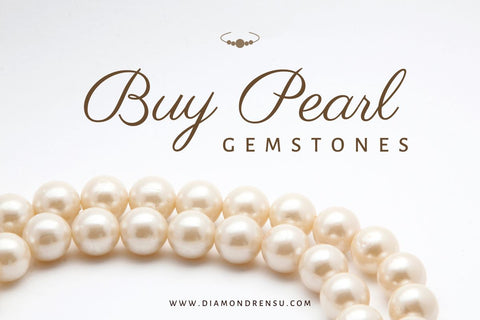
What Does a Pearl Symbolize? Unveiling Its Hidden Meanings
Pearls have long held a deep fascination and have been imbued with significant meaning across various cultures throughout history. To you, a pearl might simply be a beautiful gemstone to wear, but its symbolism extends much deeper. Historically, pearls have been seen as symbols of purity, wisdom, wealth, and status. Cultured pearls, created when a mollusk forms a pearl as a response to an irritant, can be seen as a metaphor for turning adversity into a prized aspect of life.
Premium Birthstone Rings – Big Sparkle, Better Value!
In different cultures, pearls carry diverse meanings. Some associate them with the purity and innocence of a bride on her wedding day; others see them as tears of the gods or encapsulated dewdrops. In literary and artistic expressions, such as those found in medieval and Renaissance periods, you will often come across pearls as allegorical elements representing spiritual transformation or the journey of the soul.
Table Of Contents
Importantly, pearls are unique among gemstones since they are the only ones formed within a living creature. This organic origin gives pearls an added layer of significance, underscoring themes of natural beauty and serenity. Even in contemporary times, the allure of pearls continues, and their symbolism remains influential in fashion, art, and philosophy, reminding you of the timeless connections between nature, culture, and personal adornment.
Historical Significance of Pearls
Pearls have been treasured for their beauty and rarity since antiquity, embodying wisdom, wealth, and a multitude of spiritual meanings across various cultures.
Pearls in Ancient Cultures
In Ancient Rome, pearls were considered the ultimate status symbol. The wealthy Romans were so captivated by pearls that they adorned their clothing and furniture with them. The extravagance reached a point where laws were passed to restrict pearls to the ruling classes, showcasing pearls as emblems of prestige and wealth.
The Greeks also esteemed pearls; they were synonymous with love and marriage, believed to bring protection to newlyweds. By associating pearls with matrimonial harmony and goddesses, the Greeks embedded pearls deep within their culture as icons of purity and loyalty.
Pearls in Mythology and Religion
In Chinese civilization, pearls were thought to guarantee protection from dragons and fires. They were also believed to symbolize wisdom acquired through experience, often portrayed in art as the dragon chasing after the elusive pearl.
Japanese history and folklore resonate with the spiritual aspects of pearls, viewing them as tears shed by nymphs, or the spiritual beings of the water, imbuing them with a pure, serene meaning. This relationship with water entities signifies a deeper connection between the physical beauty of pearls and their perceived ability to harmonize the spirit.
Throughout numerous cultures, pearls have maintained a strong spiritual and symbolic presence, woven deeply into the fabric of myths, religions, and historical narratives.
Pearl Formation and Characteristics
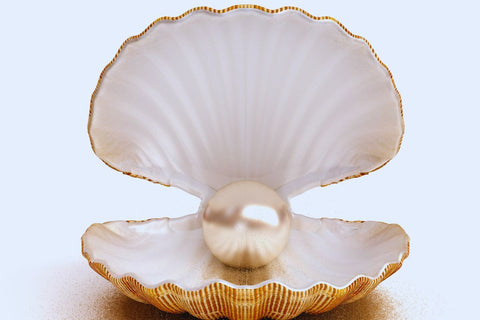
In the intricate process of pearl formation, oysters and mollusks play a pivotal role, secreting nacre to envelop irritants, ultimately yielding pearls with varying luster, shape, color, and size.
Natural vs Cultured Pearls
| Characteristic | Natural Pearls | Cultured Pearls |
|---|---|---|
| Formation | Form naturally in oysters or mollusks without human intervention. | Initiated by the introduction of an irritant (nucleus) by humans, triggering pearl formation. |
| Occurrence | Rare and found in the wild; becoming increasingly scarce due to overharvesting. | Produced through pearl farming, making them more widely available in various sizes and shapes. |
| Cost | Generally more expensive due to their rarity and natural formation. | More affordable as they are produced through controlled farming, allowing for a steady supply. |
| Shape and Size | Varied shapes and sizes, often irregular due to natural formation. | Can be cultivated to have more uniform shapes and sizes, catering to market demands. |
| Nacre Quality | Natural pearls tend to have high-quality nacre with a unique luster. | Quality of nacre may vary, but advancements in cultivation have improved overall quality. |
| Market Availability | Limited availability; considered collector's items. | Widely available in jewelry stores and markets. |
| Environmental Impact | Harvesting natural pearls may have environmental consequences and contribute to declining populations. | Cultured pearls offer a more sustainable and environmentally friendly option. |
Natural pearls are formed without human intervention. When an irritant such as a parasite enters an oyster, the mollusk secretes nacre, a substance made of aragonite and conchiolin, to coat the irritant in layers. Over time, these layers accumulate to form a natural pearl.
Cultured pearls, on the other hand, arise from a similar process, but with human involvement. An irritant is deliberately inserted into the mollusk to start the nacre secretion process. Cultured pearls can be closely regulated to achieve desired sizes and shapes, making them a popular and more affordable choice.
Properties of Pearls
The properties of pearls can vary extensively, influenced by the type and conditions of their formation:
| Property | Description |
|---|---|
| Luster | The shine or glow on the surface of the pearl, ranging from high luster to low luster. |
| Surface Quality | The smoothness and cleanliness of the pearl's surface, with fewer blemishes indicating higher quality. |
| Shape | Pearls come in various shapes, including round, oval, teardrop, button, baroque, and irregular shapes. |
| Size | Measured in millimeters, the size of a pearl can vary from small seed pearls to large South Sea pearls. |
| Color | Pearls can have a wide range of colors, including white, cream, pink, black, gold, and more. |
| Nacre Thickness | The thickness of the nacre layers contributes to the durability and quality of the pearl. |
| Nacre Quality | The overall quality and iridescence of the nacre layers that give pearls their unique luster. |
| Overtone | The secondary color that appears as a subtle shimmer over the primary body color of the pearl. |
| Origin | The geographical location where the pearl is cultivated, influencing its characteristics. |
| Cultivation Type | Whether the pearl is natural, cultured, freshwater, saltwater, or from a specific type of mollusk. |
The intricate nacre layers not only contribute to the luster but also to the overall strength and resilience of the pearl. With each unique combination of these characteristics, pearls have held a place of admiration in cultures worldwide.
Pearl Symbolism and Metaphysical Properties

Pearls have long been cherished not just for their lustrous beauty but also for their rich symbolism and metaphysical attributes. They are associated with wisdom, purity, and emotional balance, making them more than mere ornaments.
Emotional and Spiritual Associations
Pearls are believed to symbolize the purity and integrity that you carry within your spirit. They are often thought to promote a sense of calm and centeredness in your emotional life. Metaphysically, pearls are linked with healing properties that are said to help in soothing and managing emotional fluctuations. Their connection to the ocean and water also marks them as symbols of fertility and feminine energy. It's believed that wearing pearls can enhance personal wisdom gained through experience and positivity, balancing out the karma in your life.
Pearl and Birthstone Significance
For those born in June, pearls hold special significance as your birthstone. They are thought to bring love and good luck to individuals born in this month, with a spiritual meaning that encourages inner wisdom and a fortified sense of self. Pearls are more than a piece of jewelry; they act as protectors, offering balance and protection from negative energies. Throughout history, they've been adorned to attract luck and to serve as a reminder of the beauty of life, as they themselves are a product of an oyster's way of protecting itself. It's this spiritual meaning and connection to nature that enhances their allure as a birthstone that's not only beautiful but also potent with metaphysical properties.
Pearls in Fashion and Jewelry
Pearls have long been embraced to exude elegance and beauty in the world of fashion and jewelry. Their allure is often associated with occasions that range from casual elegance to grandiose celebrations, making pearl jewelry a versatile choice for your wardrobe.
Influence of Pearls on Fashion
Pearls are a symbol of timeless elegance that have influenced fashion trends for centuries. Renowned for their lustrous appeal, pearls can be found in various colors including classic white, mysterious black pearls, delicate pink, opulent gold, and serene blue. Designers incorporate these gems into a wide array of apparel, often seen embellishing clothing or as a central theme in fabric patterns.
Choosing Pearl Jewelry
When selecting pearl jewelry, consider the following aspects for a choice that best fits your style:
- Type of Jewelry: Pearls are versatile and can be crafted into various types of accessories including rings, necklaces, earrings, and more.
- Earrings: Pearl earrings range from simple studs to elaborate drops, closing the gap between everyday wear and special occasions.
- Necklaces: Whether it's a classic single-strand or a modern multi-layered piece, pearl necklaces can elevate any outfit.
- Rings: A pearl set on a ring offers a statement of sophistication, often paired with diamonds or other precious stones for an added sparkle.
- Color and Shape: Although the traditional round and white pearls are highly sought after, exploring different hues and shapes can lead to unique and personalized jewelry.
- Black Pearls: Known for their exotic aura, they are a bold choice that can make a dramatic statement.
- Colored Pearls: Pink, gold, and blue pearls offer a splash of color and can complement various skin tones and personal styles.
- Occasion and Symbolism: Pearls make excellent gifts for a range of occasions, be it a birthday, anniversary, or as a thoughtful wedding gift. Each color and design can carry its own symbolism, often representing purity, wisdom, or new beginnings.
Pearl jewelry isn't just an accessory; it's a statement of personal taste and an emblem of grace. Your choice of pearls can reflect your individuality while respecting the tradition they uphold within the realm of fashion and jewelry.
Cultural and Color Symbolism of Pearls
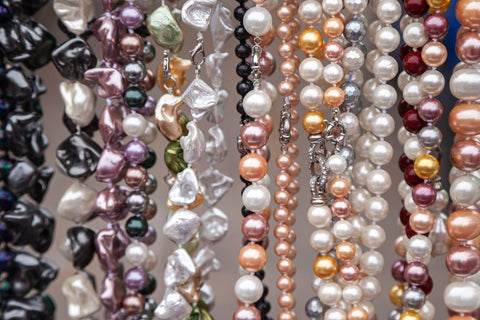
In different cultures, pearls symbolize a myriad of concepts, from wealth to wisdom, and their colors add layers of meaning. The pearl's luster and shape have become metaphors for qualities like purity and unity.
White and Black Pearls
White pearls often represent purity, innocence, and new beginnings. They are linked to the moon due to their lustrous appearance, signifying peace and tranquility. Many cultures associate white pearls with feminine energy and Venus, the goddess of love. Your white pearl might be cherished not just for its beauty but as a symbol of purity and the strength of your relationships.
In contrast, black pearls are rare and have a mystique about them. They can symbolize strength, resilience, and the mysterious depths of the water they come from. A black pearl could be a sign of wealth or status due to their rarity. These pearls are sometimes connected to the dragon in some Chinese cultures, embodying wisdom and knowledge.
Colored Pearl Significance
Beyond the binary of white and black, pearls appear in a rainbow of hues, each with its significance.
- Pink pearls: These pearls often signify love and are believed to open your heart to compassion and affection.
- Blue pearls: Reflecting the color of the sea and sky, blue pearls symbolize tranquility and truth.
- Gold pearls: They represent prosperity, wealth, and success, making them a potent emblem of achievement.
- Green pearls: Often associated with balance, growth, and hope, inviting a sense of harmony into your life.
The exact shade of a colored pearl can give you insight into its significance; deeper tones often denote richer meaning and higher value in various cultures.
Pearl Care and Maintenance
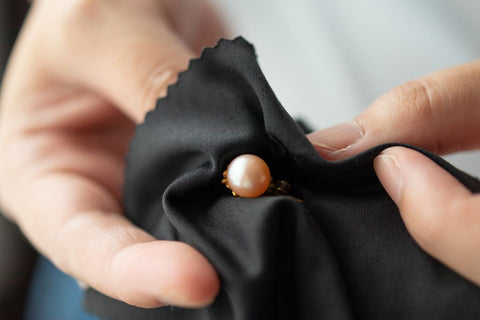
When caring for your pearl jewelry, it's crucial to preserve their luster and quality with proper maintenance and cleaning techniques. Here's how you can ensure the longevity of your pearls.
Cleaning Your Pearls
- After each wear, gently wipe your pearls with a soft, damp cloth to remove any residue.
- For a more thorough cleaning, mix a solution of lukewarm water and mild soap. Dip a soft cloth in the solution and wipe the pearls.
- Never use harsh jewelry cleaners or ultrasonic cleaners on your pearls.
Storing Your Pearls
- Store your pearls in a soft cloth pouch or a separate compartment in your jewelry box to avoid scratches.
- Avoid storing pearls in plastic bags or in direct sunlight, as this can cause deterioration.
Maintenance Tips
- Have your pearl jewelry professionally restrung every one to two years, especially if you wear them frequently.
- Before applying cosmetics, hairspray, or perfume, make sure to put your pearls on last. These substances can damage the pearl's surface over time.
By following these suggestions, you can help maintain the beauty and value of your pearl jewelry, ensuring that it remains a cherished piece for years to come.
Pearl's Influence on Relationships and Emotions
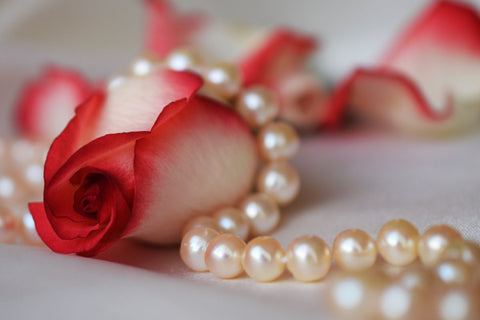
The pearl is more than just a lustrous gem; it is deeply embedded with meaning, often interwoven with the threads of relationships and the tapestry of human emotions. In the context of relationships, a pearl can be a profound symbol of love and commitment.
Pearl as a Gift
Pearls as Tokens of Affection When you present pearls as a gift, you're giving more than a piece of jewelry; you're conveying affection and loyalty. This tradition has roots in history; the giving of pearls has long been associated with imparting warmth and connection between people. For instance, in weddings, pearls might represent purity and unity, often incorporated into bridal jewelry signifying a new beginning filled with love and fidelity.
Celebrating Milestones Pearls are often chosen to celebrate significant life events such as anniversaries, childbirth, and other momentous occasions. Their association with serenity and wisdom makes them a thoughtful gift that speaks to the confidence and maturity in a relationship. A piece of pearl jewelry may symbolize the culmination of shared experiences and a celebration of enduring companionship.
Pearls and Personal Reflection Besides their role in relationships, pearls resonate with personal emotion, embodying feelings of serenity and calmness. Their subdued, gentle iridescence can provide a sense of comfort and stability, reinforcing your self-confidence and inner peace. This dual aspect of pearls affecting both communal and personal spheres underscores their unique position in the symbolism of gems.
Frequently Asked Questions
Pearls have held a deep symbolic meaning across various cultures and contexts, often seen as tokens of wisdom, purity, and wealth. Explore these nuances through common inquiries about their symbolism.
What is the spiritual significance of white pearls?
White pearls are often associated with innocence and purity. They are thought to symbolize purity of intent and steadfast faith in various spiritual and cultural traditions.
How is a pearl's symbolism represented in the story 'The Pearl'?
In the story 'The Pearl', the pearl represents a complex web of symbolism including hope, wealth, and the struggle between man's aspirations and the hardships of reality.
What does the gift of a pearl necklace traditionally signify?
Traditionally, the gift of a pearl necklace is a meaningful gesture, often signifying a milestone or conveying the message of love, commitment, and thoughtfulness.
Can you explain the meaning behind wearing pearls?
Wearing pearls is seen to promote a sense of calmness and centeredness, signifying dignity and elegance. It's also believed to attract good fortune and wealth.
In the context of a wedding, what do pearls symbolize?
During a wedding, pearls often symbolize new beginnings and purity, embodying the beauty and integrity of the union between two individuals.
What meanings are commonly associated with pearls in regard to femininity?
Pearls carry meanings of feminine wisdom, serenity, and grace. They are traditionally connected to symbolizing a woman's perfect elegance and the nurturing aspect of her nature.
Checkout some of our top collections:
